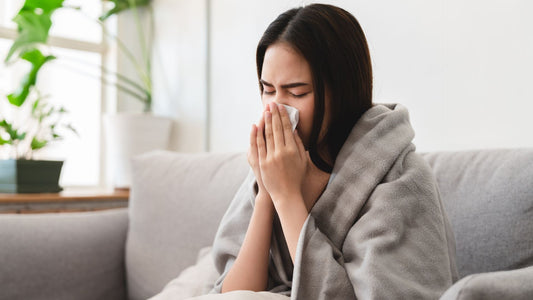
High blood pressure: What can I do about it myself?
Prevention as a key factor
Today we would like to inform you about a typical common disease in Germany - high blood pressure. Are you maybe even affected yourself? How does this disease arise and what can we do ourselves against? How important are prevention measures? We clarify them.
Are you affected by high blood pressure yourself?
Hypertension, also called hypertension, is a widespread disease that affects millions of people worldwide. Around 20 to 30 million people are affected in Germany, which is almost every third adult. Thus, high blood pressure in Germany has long been a common disease. Often referred to as "silent illness", high blood pressure often remains unnoticed until it causes serious health complications. The disease can affect people in all age groups, but the risk increases significantly with age. A large part of those affected receive their initial diagnosis aged 40 to 50 years.
When do you speak of high blood pressure?
Hyperture exists when the blood pressure in the arteries is increased over a longer period of time. The blood pressure is measured in millimeter mercury column (MMHG) and shown by two values: the systolic pressure (the pressure during heartbeat) and the diastolic pressure (the pressure between the heart beats). A normal blood pressure is typically below 120/80 mmHg. Permanent values higher than 140/90 mmHg are considered high blood pressure.
High blood pressure severe degrees
|
Severity |
Systolic blood pressure (mmhg) |
Diastolic blood pressure (mmhg) |
|
Optimal blood pressure |
< 120 |
< 80 |
|
Normal blood pressure |
120 - 129 |
80 - 84 |
|
Highly normal blood pressure |
130 - 139 |
85 - 89 |
|
Hypertension degree 1 |
140 - 159 |
90 - 99 |
|
Hypertension degree 2 |
160 - 179 |
100 - 109 |
|
Hypertension degree 3 |
≥ 180 |
≥ 110 |
-
Optimal blood pressure: Ideal state, low health risks
-
Normal blood pressure: Also healthy, slightly increased, but harmless
-
Highly normal blood pressure: Increased risk of developing high blood pressure
-
Hypertension degree 1: Light hypertension, first stage of high blood pressure
-
Hypertension degree 2: Moderate hypertension, requires medical treatment
-
Hypertension degree 3: Heavy hypertension, high risk of cardiovascular complications, intensive treatment necessary
Causes and risk factors
-
Genetic predisposition: A family history of high blood pressure increases the risk immensely.
-
Unhealthy lifestyle: Obesity, lack of exercise, a salt -rich diet and excessive alcohol consumption are significant risk factors.
-
Age: The risk increases with age. From the age of 40, the likelihood of developing high blood pressure increases significantly.
-
Stress: Chronic stress, permanent tension and fear can increase blood pressure.
-
Chronic diseases: Diabetes, kidney diseases and sleep apnea are often associated with high blood pressure.
-
Lack of sleep: Already 1-2 hours less sleep can lead to increased blood pressure. Regular sleep of less than six hours, the risk of developing high blood pressure increases by 60%.
Symptoms and complications
Hypertension is often diagnosed very late because it usually hardly causes symptoms over a longer period of time. If untreated, however, high blood pressure can lead to serious health problems and complications.
Symptoms of high blood pressure
Hypertension, also called hypertension, is often referred to as "silent illness" because it often runs without striking symptoms. Many people do not know that they suffer from high blood pressure until serious health complications occur. However, this is often only after many years The case.
-
Headache: Especially in the back of the head and in the morning after waking up, often occurs with high increased blood pressure.
- Dizziness: A feeling of drowsiness or fluctuations can occur in fast movements and changes to the position.
- Nosebleeds: Often and for no obvious reason, usually occurs with very high blood pressure.
- Shortness of breath: Difficulties in breathing, especially physical exertion, can indicate a participation of the heart.
-
Visual disturbances: Surious seeing or seeing flashes of light can indicate damage to the blood vessels in the eyes.
-
Breast pain: Pressure or tightness in the chest, a serious symptom that requires immediate medical help.
-
Pounding of heart/racing heart: Irregular or quick heartbeat can indicate a participation of the cardiovascular system.
-
Fatigue: Persistent exhaustion and weakness can be caused by the constant stress on the body by the high blood pressure.
-
Oceans: EIn pulsating sound in the ears, can indicate increased blood pressure.
-
Blood in the urine: If there is an indication of kidney damage, immediate medical clarification requires.

Complications of high blood pressure
- Cardiovascular diseases: Hypertension increases the risk of heart attack, stroke and heart failure.
- Kidney damage: High blood pressure can damage the blood vessels in the kidneys and lead to kidney failure.
- Eye problems: Damaged blood vessels in the eyes can lead to visual loss.
- Aneurysms: Hypertension can cause weaknesses in the artery walls, which can develop into life -threatening aneurysms.
- Peripheral arterial closure disease (PAVK): Hypertension can narrow the arteries in the limbs, which leads to progressive circulatory disorders and pain.
- Heart rhythm disorders: High blood pressure can change the structure of the heart and lead to arrhythmias.
- Vascular calculation: A long -term increase in blood pressure can lead to arteriosclerosis, hardening and narrowing of the arteries.
Diagnosis and treatment
Hyperture is diagnosed by repeated blood pressure measurements. If there is suspicion of high blood pressure, the doctor will create a thorough medical history and possibly other tests such as blood and urine analyzes or an electrocardiogram (EKG)
carry out. The treatment of high blood pressure usually includes a combination of lifestyle changes and medication with pronounced high blood pressure:-
Lifestyle changes: A healthy diet (little salt, rich in fruit and vegetables), regular physical activity, weight reduction, stress management and stopped smoke are crucial.
-
Medicines: Various drugs can help control blood pressure, including diuretics, beta blockers, ACE inhibitors and calcium channel blockers.
Prevention measures
Prevention is the key to reducing the risk of high blood pressure. Here are some tips for prevention:
Primary prevention
Primary prevention aims to prevent the occurrence of high blood pressure. The measures include:
- Nutrition management: A balanced diet with lots of fruit, vegetables and whole grains as well as little salt (max. 5G per day According to recommendations from the WHO).
- Regular movement: For least 150 minutes of moderate physical activity per week are recommended.
- Weight management: Maintain or achieve a healthy body weight that Body mass index is considered guidance
- Stress reduction: Techniques such as meditation, yoga, autogenic training and breathing exercises can help to cope with stress.
- Definition of smoking and moderate alcohol consumption: Give up smoking and consume alcohol only in moderation (20 grams of alcohol in men and 10 grams of alcohol in women every day, should Lcar German Nutrition Society (DGE) are not exceeded)
Secondary prevention
- Regular blood pressure controls: People with risk factors in particular should have their blood pressure checked regularly.
-
Early detection: Health checks and screenings help to recognize high blood pressure in early stages and to treat them accordingly.
-
Enlightenment and advice: Patients inform about the risks of high blood pressure and the importance of compliance with the treatment.
Tertiary prevention
This aims to avoid complications with already diagnosed hypertension and to improve the quality of life.
-
Consistent treatment: Regular intake of prescribed medication and continuous medical care.
-
Keeping lifestyle changes: Even after the diagnosis, healthy eating, regular exercise and stress management are decisive.
-
Monitoring and management of companions: Treatment and control of diseases such as diabetes, kidney diseases and heart diseases.

Nutrition - blood pressure -lowering foods
- Fruit and vegetables: Berries, bananas, oranges, tomatoes, green leafy vegetables and beetroot are particularly rich in potassium. Blueberries and strawberries in particular contain antioxidants that can improve blood vessel function.
-
Legumes and nuts: Beans, lentils and nuts such as almonds and walnuts are good mineral sources and contain fiber.
-
Linseed: Rich in omega-3 fatty acids that can lower blood pressure.
-
Fish: Salt water fish such as salmon, herring, mackerel and sardines are rich Omega-3 fatty acids that have anti-inflammatory properties.
-
Whole grain products: Oatmeal, quinoa and whole grain breads contain fiber that have a blood pressure regulating and anti -inflammatory effect
-
Garlic: Garlic has blood pressure -lowering properties due to its ability to expand the blood vessels. The chemical compound alicen is responsible for this
-
Olive oil: Rich of simply unsaturated fatty acids and olive acid, olive oil can help reduce blood pressure and cholesterol levels and to improve heart health.
-
Hibiskus tea: Hibiscus flowers are rich in antioxidants such as beta-carotene and vitamin C. Hibiskus therefore has blood pressure-lowering and cholesterol-lowering properties.

Independent blood pressure measurement: step-by-step instructions
Even measuring blood pressure is a useful skill to keep control of your own health and to recognize abnormalities in good time. Here is a step-by-step instructions on how you can do this:
What you need
Set one Automatic blood pressure monitor ready. These devices are easy to use and require little manual inputs. You measure the blood pressure either on the upper arm or wrist. With a little practice, both methods can be carried out independently without outside help.
Preparation
Insert a rest phase: Sit down for at least 5 minutes before measuring the blood pressure.
Suitable environment: Measure the blood pressure in a quiet environment without distractions.
Empty bubble: Go to the toilet beforehand as a full bubble can increase blood pressure.
Attitude: Sit down with a straight back and without crossed legs. The arm should rest at heart height, preferably on a table.
Measuring process with an automatic blood pressure monitor
- Create the cuff: Create the cuff of the device about 2-3 cm above the elbow. It should be tight, but not too firm.
- Positioning the arm: Place your arm so that it is at heart height. Relax your arm.
- Start the measurement: Turn on the device and start the measurement according to the manufacturer's instructions.
- Waiting for the result: The device pumps the cuff on and then slowly lets the pressure off. After a few seconds, the display shows the measurement results (systolic and diastolic blood pressure as well as pulse).
Frequency of measurements
-
Measure the blood pressure at different times of the day to get a precise picture.
-
Perform the measurements several times and write down the results to recognize trends, a measurement within the first and second half of the day is suitable. Additional measurements with discomfort or dizziness always make sense to get an overall impression.
More tips
-
Avoid consumption of caffeinated drinks or smoking at least 30 minutes before the measurement.
-
The same conditions: try to always carry the measurements sitting under similar conditions in order to obtain comparable results.
-
You can generally carry out blood pressure measurements on both poor. If you measure for the first time on both upper arms, the values differ from each other, so you choose the arm for the other regular measurements with the higher values.
documentation
Guide a blood pressure diary to document the values and present your doctor if necessary. So you can quickly recognize a certain regularity or deviations. Remember to write down special features such as physical exertion before measuring or dizziness.

Conclusion
Hypertension is a serious disease that often remains unnoticed until it leads to serious health problems. In Germany, millions of people are affected, which underlines the urgency of preventive measures. With regular independent blood pressure controls, healthy lifestyle, the inclusion of blood pressure -lowering foods and, if necessary, drug treatment, the risk of complications can be significantly reduced. With a light hypertension, a consistent change in the lifestyle is often sufficient to reduce blood pressure sustainably, so that no medication are necessary. Anyone who informs themselves in good time and actively takes measures can protect their health sustainably. Do not hesitate and take your health into your own hands.




















